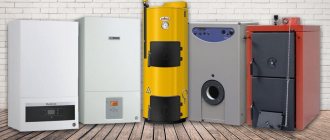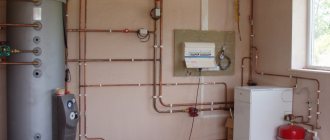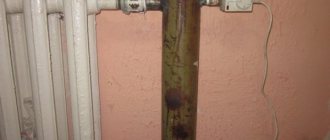The selection and installation of heating systems is a topic in which the homeowner must be well versed, even if he decides to entrust these tasks to specialists.
Otherwise, heating your home may turn out to be not only unreasonably expensive, but also ineffective.
It is even more worthwhile to study this issue if you intend to install the heating system of a private house with your own hands. We hope that our article will be a worthy assistant in this important matter.
Types of boilers for heating a private house
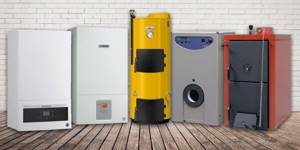
At the heating system design stage, the homeowner may be faced with a seeming variety of boilers. Selecting the right unit will simplify the availability of energy resources. Manufacturers produce 4 types of heaters: electric, gas, solid and liquid fuel boilers. The latter modification is rarely used due to the high price of fuel (mainly diesel).
The most common boilers are those using natural gas. They operate in manual or automatic mode and do not require constant monitoring. Even budget models are able to independently maintain the temperature at a given level. A significant limitation in using a gas boiler is the availability of fuel. If there is no gas pipeline connected to the house, the owner will have to look for another source of heat.
Electric boilers can become an alternative to gas ones. However, the cost of electricity is higher compared to blue fuel. The heaters also operate automatically, they are silent and take up little space, which eliminates the need for a separate room for installation of equipment. In addition, they do not require the construction of a chimney.
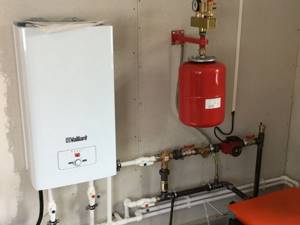
In the absence of access to a gas pipe and unwillingness to pay electricity bills, homeowners install boilers that burn solid fuel. You can burn wood, coal, and pellets in them. However, such heaters require constant supervision: as the fuel burns out, it must be periodically added and the ash must be removed. In addition, solid fuel boilers are installed in a separate room so that soot does not settle in living rooms.
For your information!
Some manufacturers produce automatic solid fuel boilers with ultra-long burning. They independently regulate the temperature of the coolant, and fuel enters them from the bunker, which ensures continuous operation of the unit.
Work order
If everything is ready, you can begin installation. Here are its main stages:
Boiler installation
The connection of the heat generator to the gas supply system can only be carried out by an employee of the gas industry, but the user has the right to do everything else independently. First of all, you need to choose the right location for the boiler. It should be located closer to the chimney, so that the length of the pipe connecting them does not exceed 25 cm. The cross-sectional area of the chimney should be no less than that of the boiler smoke exhaust pipe.
The volume of the room must be at least 15 cubic meters. m, and with a boiler power over 75 kW - 0.2 cubic meters. m for every kilowatt.

Heating scheme with gas boiler
The room must have a window, the minimum area of which is determined at the rate of 0.03 square meters. m for each cubic. m volume.
Fresh air must enter the boiler room - directly from the street or through an adjacent room, for example, through the kitchen.
Polymer pipes cannot be connected directly to the boiler. There must be a metal section at least 3 m long between them and the heat generator.
Choosing a heating system is a crucial step. The efficiency and costs of heating the room depend on this. Types of heating of a private house - see a brief overview of existing schemes.
In what cases is an expansion tank needed for heating? Read here.
And in this topic https://microklimat.pro/sistemy-otopleniya/dvuxtrubnaya/chastnogo-doma.html everything is about the pros and cons of a two-pipe heating system. Operating principle, calculation and installation.
Marking
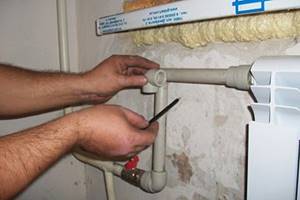
Before proceeding with the installation of the heating system, you need to mark on the walls the location of fasteners and holes for passing pipes.
It is most convenient to mark the holes for the radiator brackets using a template.
If you intend to use long sectional radiators, then the brackets must be placed not only at the edge, but also in the middle, in order to avoid sagging of the device with its subsequent deformation and depressurization.
Installation of equipment and installation of heating system pipelines
Let's consider the installation of a heating system made of polypropylene pipes. Before hanging the radiator on the wall, you can attach a sheet of foil, which will reduce heat loss by reflecting infrared radiation. Another useful trick is to install a smoothly curved tin canopy over the radiator, which will make it easier for heated air to escape from under the window sill.
The circulation pump is installed on the return line just before the boiler. Here the coolant is the coldest, which means the pump will last longer.
This area is also well suited for a membrane expansion tank. The latter really does not like turbulence, and it is almost never observed just before the circulation pump.
The air vent is installed at the highest point of the circuit.

Complete heating system with piping
Connections in polypropylene and metal-plastic pipelines are made in different ways. Polypropylene parts are welded, for which they need to be heated on a special tool, commonly called a soldering iron or iron.
The holding time is strictly regulated and depends on the diameter of the part and the thickness of its wall. After heating, one of the parts is put on the other and as they cool, they form a durable alloy.
Under no circumstances should polypropylene pipes be butt welded together without using a coupling. Such a connection will not withstand internal pressure and will leak very quickly.
To connect a metal-plastic pipe to a fitting or radiator, you need to attach a fitting to it. There are two types of fittings:
- Crimping: the most affordable, and therefore the most popular option. The part consists of a fitting, a split ring (cracker) and a union nut. The nut is put on the pipe first, then the cracker, after which the fitting is inserted into it. Now the cracker needs to be pushed onto the fitting, followed by the union nut, which is screwed onto the thread on the fitting. You need to tighten the nut until you hear the material creaking four times. Compression fittings have a significant drawback: they have to be tightened from time to time, otherwise they will begin to leak. For this reason, they cannot be walled up in walls.
- Press fittings: more expensive, but also a much more reliable type. The fitting has a sleeve, which is pressed with special pliers around the fitting after the pipe is put on it. With this design, leaks are excluded, so pipes with press fittings can be laid in a hidden way without fear.
Before pulling the pipe through a hole in the wall, wrap the end with plastic wrap to prevent debris from getting inside.
The assembled system must be subjected to pressure testing - crimping. To do this, use a manual or electric crimper. With its help, a pressure of 1.5 - 2 times higher than the nominal pressure is created in the system for several hours.
If the pressure gauge readings did not change during the tests, then there are no leaks.
Requirements for boiler installation
The norms and rules that ensure trouble-free operation of boilers vary for each type of heater. The most stringent requirements are imposed on units operating on gaseous fuel. This is associated with the risk of depressurization and subsequent explosion of the gas-air mixture. When installing heating in a private home, the homeowner should be guided by several documents:
- SNiP 41-01-2003 “Heating, ventilation and air conditioning”;
- SNiP 21-01-97 “Fire safety of buildings and structures”;
- SNiP 2.04.01-85 “Internal water supply and sewerage of buildings.”
To approve the project, the homeowner submits an application to the local utility service, which specifies the type of equipment to be installed. After considering the request, the regulatory authority agrees on the technical conditions that must be fully implemented when installing the boiler and heating system. The next stage is drawing up and agreeing on the project. The processing time for the latter depends on the complexity and can range from several weeks to 3 months. If the project has not received approval, then the applicant is given a list of actions that need to be performed to obtain a positive conclusion.
System recharge
Closed-type heating systems are equipped with outlets for recharging the circuit with coolant. If water is used as the coolant, the return heating circuit can be connected directly to the water supply. The replenishment will be done through shut-off valves and a mud filter (a softener filter will also be useful here).

A pressure gauge will help track the pressure difference in the forward and return lines.
If antifreeze is used as a coolant, then a special branch is made in the circuit for pumping antifreeze. Also, do not forget about the coolant drain taps, which cut into the lowest point of the system.
Requirements for a boiler room in a separate building
Boilers and related equipment may be installed in a separate building - a boiler room. The dimensions of the latter, as well as the building materials from which it is made, are regulated by the relevant SNiPs. More stringent requirements are established for a gas boiler room, since during its operation an explosion and fire of the gas-air mixture is possible. Such a project must be approved by the supervisory authorities.
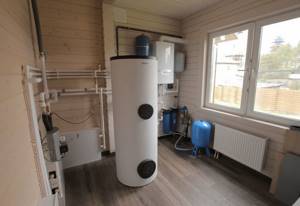
For your information!
The latest change in legislation regulates the installation of a gas alarm, which automatically stops the gas supply to the boiler room when a leak is detected. This standard applies to boiler units with a capacity of more than 60 kW.
For boiler rooms that are designed for equipment running on electricity or solid fuel, less stringent requirements are put forward, since the unit in this case is not classified as explosive. Therefore, design and construction work can be done independently. When constructing a building, non-flammable or low-combustible materials are used to prevent the spread of fire in the event of a fire.
Balancing according to design calculations
The easiest way is to balance the system using the data specified in the heating project. The essence of balancing, regardless of the chosen method, comes down to setting the required coolant flow in various parts of the system. The flow is regulated using balancing valves or thermostatic valves with presetting.
The balancing valve has its own gradation. In this case, the different positions of the control valve correspond to a certain volume of coolant that is capable of passing through the device per unit time at a given pressure.
If you have a project for a heating system, you can properly balance it quite simply: by setting the coolant flow rate in accordance with existing calculations.
Evgeniy Kruchinin
But it is important to take into account the fact that often design calculations differ from the actual parameters of the heating system. For example, the hydraulic resistance of a heating circuit can be easily changed by adding or removing an element from the system. But, in general, a good and correct project is a rarity for private houses.
Therefore, even if there is a project, the balancing methods presented below do not lose their relevance.
How to install a heating boiler in a private house with your own hands

Most models have built-in circulation pumps and expansion tanks. The simplest and most common piping scheme involves the location of a supercharger with a bypass line and a sump on the return line. An expansion tank is also installed there, which is necessary to compensate for the temperature increase in the volume of the coolant. A pressure gauge is used to monitor pressure, and air is removed from the boiler circuit through an automatic air vent.
A solid fuel heater must be equipped with an external circulation pump, an expansion tank and a safety group. Additionally, a cooling circuit is installed, designed to lower the temperature of the coolant in case of overheating. To protect the internal surfaces of the boiler from condensation, the system is equipped with a three-way valve that regulates water heating.
Heating of private housing construction can be implemented independently. The owner must carefully comply with the requirements of regulatory documents, follow the recommendations of manufacturers and the advice of specialists. The successful completion of installation is facilitated by watching videos that show the step-by-step execution of the work.
Radiator control and shut-off valves
Heating radiators are equipped with half-turn ball valves, which allow you to completely shut off or, conversely, open the coolant supply to the radiator. Taps are placed at the entrance to the device. Sometimes thermostatic radiator valves (without presetting) are used instead, which automatically shut off the coolant supply when the room temperature exceeds the set values.
The listed devices cannot be used to balance the system. Balancing valves (valves) and thermostatic valves with presetting serve these purposes.
Calculation of heat consumption for ventilation
To obtain an overall indicator of heat loss at home, the losses of each room separately are summed up. To complete the picture, it is also necessary to take into account the heating of ventilation air. The simplest formula for calculating this parameter is Qair = cm (tв – tн), where:
- Qair – calculated amount of heat for ventilation, W;
- m – amount of air by mass, defined as the internal volume of the building multiplied by the density of the air mixture, kg;
- (tв – tн) – as in the previous formula;
- с – heat capacity of air masses, is taken equal to 0.28 W / (kg ºС).
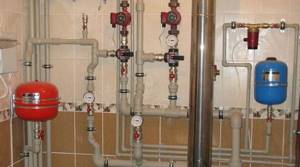
To determine how much heat is needed for the entire house, add the value of QTP for the house as a whole with the value of Qair. The boiler power must be taken taking into account the reserve for the optimal level of operation (a coefficient of 1.3 is used). In the case when the boiler will provide not only heating of the coolant for the heating system, but also water for the hot water supply, the safety margin will need to be increased. It is necessary to ensure efficient operation of the boiler on 2 circuits at once, which implies the use of a safety factor of 1.5.
Temperature balancing
To balance the system by temperature, we will need the already familiar balancing valves (or thermal heads with presetting) and an electronic thermometer for non-contact measurement of surface temperature.
Balancing begins with the balancing valves on the last and penultimate radiator being fully opened. The coolant flow rate on the first, as well as on subsequent radiators from the boiler, is set to minimum values (with an increase in flow rate as the radiators move away from the boiler).
For example, if there are 8 radiators installed in the system, and the balancing valve screw is adjusted within 4.5 turns, then the first radiator from the boiler is first completely closed, then its balancing valve is unscrewed by 1.5 turns. The regulator of the second radiator is unscrewed by 2 turns, the third by 2.5, and so on. The coolant flow on the last and penultimate radiator in most cases remains maximum. If possible, adjustments are made only on those radiators that are closest to the boiler (the distance is measured from the beginning of the supply line).
It is not recommended to unscrew the regulator less than 1.5 turns. After all, if you turn down the throttle opening of the valve too much, the device will quickly become clogged with scale or other debris.
Fine adjustments are made according to the readings of the thermometer. The main goal of balancing in this case is to achieve approximately the same temperature difference at the inlet and outlet of each radiator.
If the temperature difference at the inlet and outlet of a single radiator reaches 10ºС, it is not recommended to close its balancing valve even more.
And one more thing: noise in the radiator during operation of the heating system indicates that the coolant flow should be reduced.
Commissioning of electrical equipment

Commissioning work that accompanies electrical installation work is a set of works that includes checking, adjusting and testing electrical equipment in order to ensure the electrical parameters and modes specified by the project. Qualified commissioning work carried out by electrical installation employees will not only be able to identify possible violations during electrical installation work and shortcomings in the operation of the equipment before it begins operation, but will also ensure its guaranteed operation for quite a long time.
Polypropylene
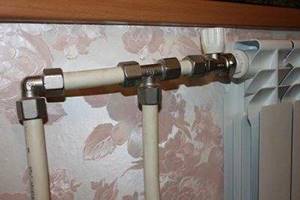
For heating, polypropylene pipes reinforced with aluminum or fiberglass are used.
Installation technology:
- Warm up the soldering iron before use for 10 minutes to a temperature of 260±10 ºC.
- Cut the workpiece with a special knife.
- Treat its end with a special stripper to completely remove the aluminum layer.
- Degrease the joints with alcohol.
- Mark the distance at which the workpiece will enter the welding nozzle: for size 16 – 13 mm; for 20 – 14 mm; for 25 – 15 mm.
- Insert the pipe blank and fitting into the soldering iron nozzles.
- Count the heating time: for sizes 16 and 20 – 5 seconds; for 25 – 7 sec.
- Remove the parts from the soldering iron.
- Quickly, without allowing it to cool, insert the pipe into the fitting. Fix the connection motionless: for sizes 16 and 20 – at least 6 seconds; for 25 – at least 10 seconds.
Attention! A common installation defect is overheating of the material in the soldering iron, resulting in a narrowing of the pipe flow in the fitting
Clients about us:

Object: Mozhaisk district of SNT Khoroshilovo.
Task: Installation of heating in a dacha of 80 m2 Installation of a Kupper solid fuel boiler.
Equipment: Solid fuel boiler, pump for the heating system, heating fluid, radiators, polypropylene pipes.
Customer review: “I contacted the VashKomfort company to install a heating system in my dacha. The guys did the job in two days. I liked everything, I'm very satisfied. I recommend. "
Antonina
